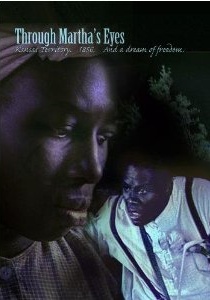Washburn University
 Center for Kansas Studies
Center for Kansas Studies


Through Martha's Eyes
Article Written by: Nicole Etcheson, Ball State University
*Article used with permission from the Kansas Historical Society*
We first see Martha (Asona Lui) riding in the back of a wagon headed for Kansas Territory, just after having been purchased in Missouri by the Reverend Thomas Johnson. Indeed, Johnson ran a vocational school for Native Americans in Kansas Territory, and he did buy a fi fteen-year-old girl named Martha in May 1856 (http://www.territorialkansasonline.org). The story of this girl becomes the lens through which the viewer of Through Martha’s Eyes sees slavery in the Upper South, the plight of Native Americans, and the turmoil of Bleeding Kansas.
The film is most effective as an account of slavery in a non-plantation setting. The Kansas territorial census shows that most slave owners in Kansas possessed only one or two slaves, usually a woman or a child. In the fi lm, the Johnsons are shown with only one other slave besides Martha, an older woman. Martha does the many kinds of labor a slave might do in the territory, from laundry to skilled fancy sewing. Drunken Missourians leer suggestively at Martha on one occasion, hinting at the sexual violation slave girls so often endured. One subplot concerns a secret night school in which Martha learns to read and write. This reveals slaves’ fierce desire for education as well as the hidden lives they often led under the master’s nose.
When Martha and the free black barber, John, fall in love, they speak of “jumping the broomstick,” the slave marriage ceremony. Even as Martha and John contemplate forming a new family, we are reminded of the cruel breakup of slave families: Martha mentions her mother; John did not know either parent. The reverend’s wife, Sarah Johnson, becomes concerned that Martha’s friendship with John might lead to un-Christian behavior, but the Christian missionary woman is not above having Martha brutally whipped for disobedience. Yet, despite the graphic evidence of the slave’s oppression, Martha is not totally helpless. In an early scene, she cleverly manipulates Sarah Johnson into granting permission to take in sewing, in addition to her regular work, in order to save the money to purchase her freedom. The fi lmmakers have packed a lot of information about slave life into their narrative.
The film also offers a view of Indian manual labor schools. Our understanding of these institutions has been dominated by Carlisle, Haskell, and other such institutions of the late nineteenth century that sought to assimilate American Indians. Here, we see a pre-Civil War incarnation of the same assimilationist agenda. One of Martha’s tasks is to cut Native American children’s hair when they arrive while Sarah Johnson gives them new, English names. Martha also cuts away any sacred bundles the parents may have secreted on the children. We see something of the diffi culties oppressed peoples experienced in realizing their shared oppression, as Martha initially disdains Emily Blue Jacket (whom she calls Emily Blue Nose), the Native American graduate of the mission school.
The climax of the film comes when Martha, influenced by John, fully realizes this common oppression. John believes the Native Americans are trying to retain their own identities. Martha does not understand this at fi rst, saying that the Indians are Americans. After one nighttime school session, Martha and John dance. John teaches Martha the steps the white Missourians will be dancing at an upcoming ball for which Martha is sewing a gown, and Martha shows him an African dance. John tells her not to forget to dance “like your own people.” When Sarah Johnson next demands that Martha cut the Native American children’s hair and sacred bundles away, Martha refuses, an offense for which she is whipped.
The film is least successful in telling the story of Bleeding Kansas. Martha sees the Missourians preparing for an attack on Lawrence. In a later scene, Martha and Emily tend the Southern wounded, but it is not clear which mobilization of several against Lawrence is being depicted or where or how the wounded were hurt. Brief vignettes show the belligerence—and drunkenness—of the Missourians (listed as “ruffi ans” in the credits), which run true to much of the literature, especially as written by the free-state side. The political and military events of Bleeding Kansas, however, are simply too complicated to be told as part of Martha’s story. A slave such as Martha—confined to one place in the territory—would have limited exposure to these events. The view of Bleeding Kansas through Martha’s eyes cannot go beyond a few isolated incidents, making it impossible to develop the range of occurrences and ideologies that made up the territory’s crisis.
Despite this caveat, the fi lmmakers have done an excellent job portraying themes about slavery that historians value, especially the tension between oppression and agency, between the suffering slaves endured and their ability to resist hardship and shape their own destinies. After Martha is whipped, we see her rise the next day and resume her sewing. From that sewing she will earn money to buy her liberty. At the end, Martha and John set out westward after having purchased her freedom. The wideopen spaces of Kansas, much depicted in this fi lm, give a sense of limitless possibilities. Even a slave could have hope.
Nicole Etcheson
Ball State University
